Radiography Report: Radiography of Geriatric Patients and Care
VerifiedAdded on 2021/06/16
|5
|1004
|245
Report
AI Summary
This report focuses on the use of radiography in geriatric patients, highlighting its importance in diagnosing age-related conditions and comorbidities. It emphasizes the need for a patient-centered approach, considering the individual needs and preferences of elderly patients undergoing radiology techniques. The report discusses the role of radiation exposure, regulatory guidelines such as IRMER, and the Society of Radiographers' standards for safe practice. It explores the psychological impacts of radiology on geriatric patients, the importance of effective immobilization, and the potential risks associated with ionizing radiation, including a possible link to Alzheimer's disease. The report concludes by emphasizing the challenges faced by radiologists and the necessity of collaboration among healthcare professionals to effectively manage geriatric patients in a radiography setting.
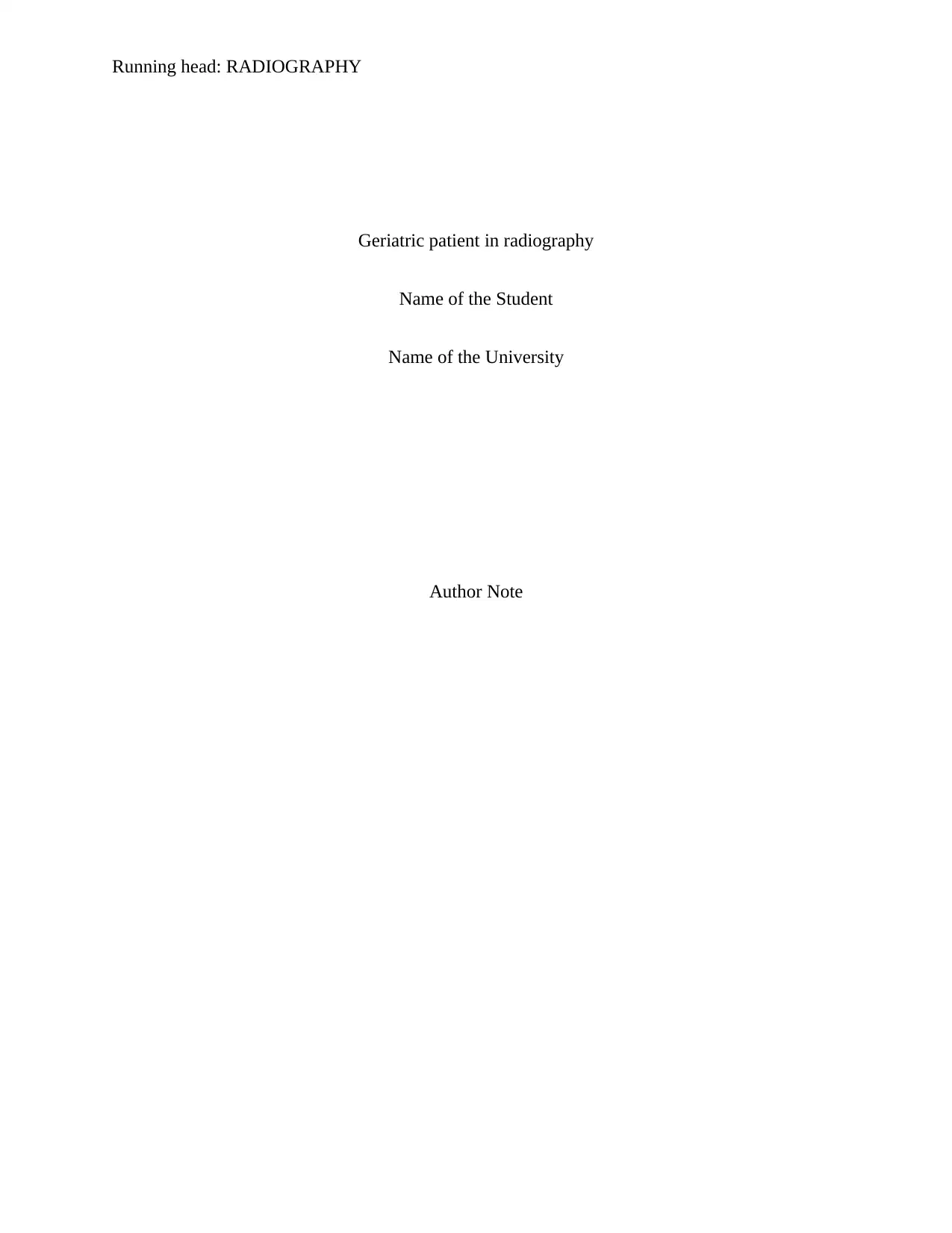
Running head: RADIOGRAPHY
Geriatric patient in radiography
Name of the Student
Name of the University
Author Note
Geriatric patient in radiography
Name of the Student
Name of the University
Author Note
Paraphrase This Document
Need a fresh take? Get an instant paraphrase of this document with our AI Paraphraser
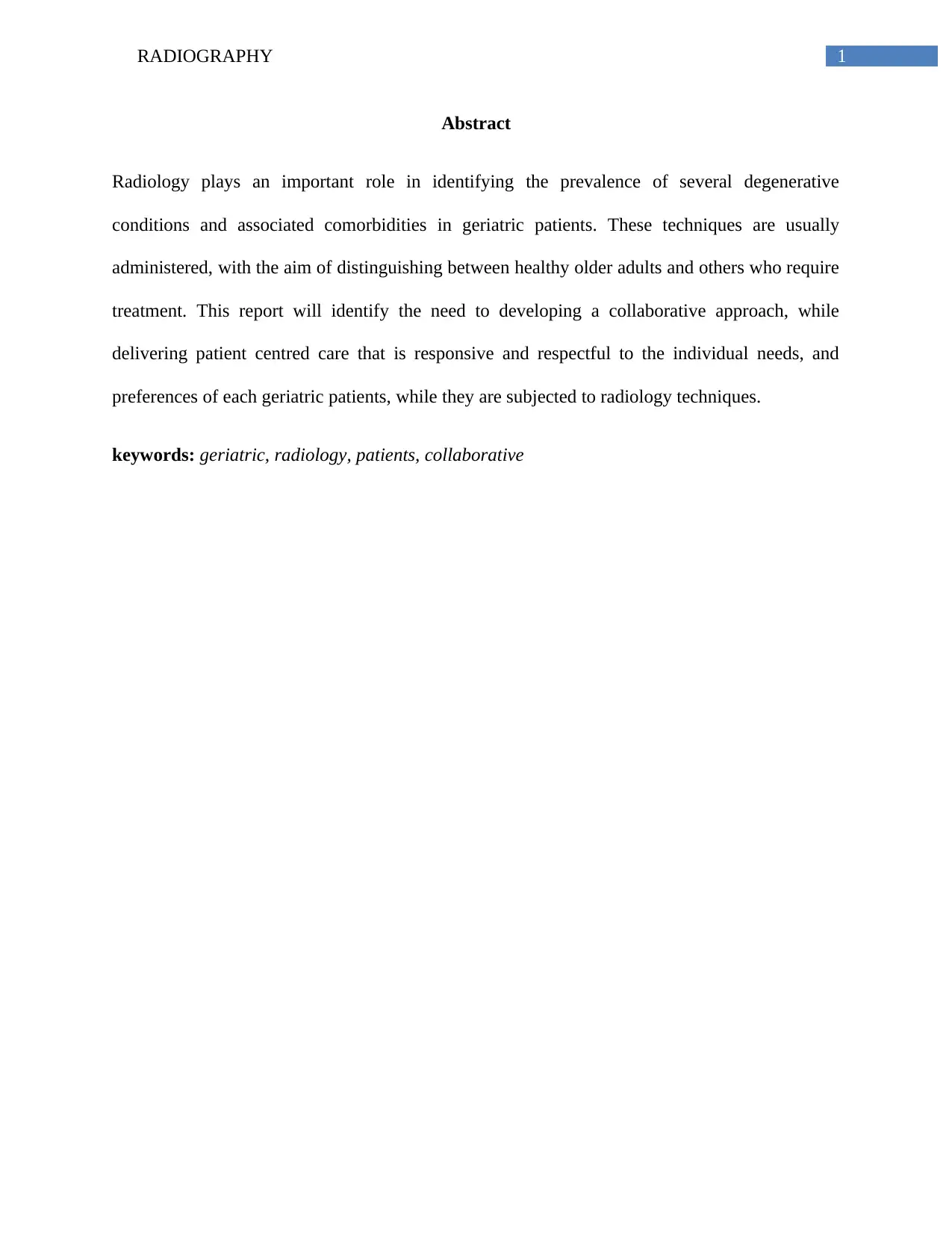
1RADIOGRAPHY
Abstract
Radiology plays an important role in identifying the prevalence of several degenerative
conditions and associated comorbidities in geriatric patients. These techniques are usually
administered, with the aim of distinguishing between healthy older adults and others who require
treatment. This report will identify the need to developing a collaborative approach, while
delivering patient centred care that is responsive and respectful to the individual needs, and
preferences of each geriatric patients, while they are subjected to radiology techniques.
keywords: geriatric, radiology, patients, collaborative
Abstract
Radiology plays an important role in identifying the prevalence of several degenerative
conditions and associated comorbidities in geriatric patients. These techniques are usually
administered, with the aim of distinguishing between healthy older adults and others who require
treatment. This report will identify the need to developing a collaborative approach, while
delivering patient centred care that is responsive and respectful to the individual needs, and
preferences of each geriatric patients, while they are subjected to radiology techniques.
keywords: geriatric, radiology, patients, collaborative
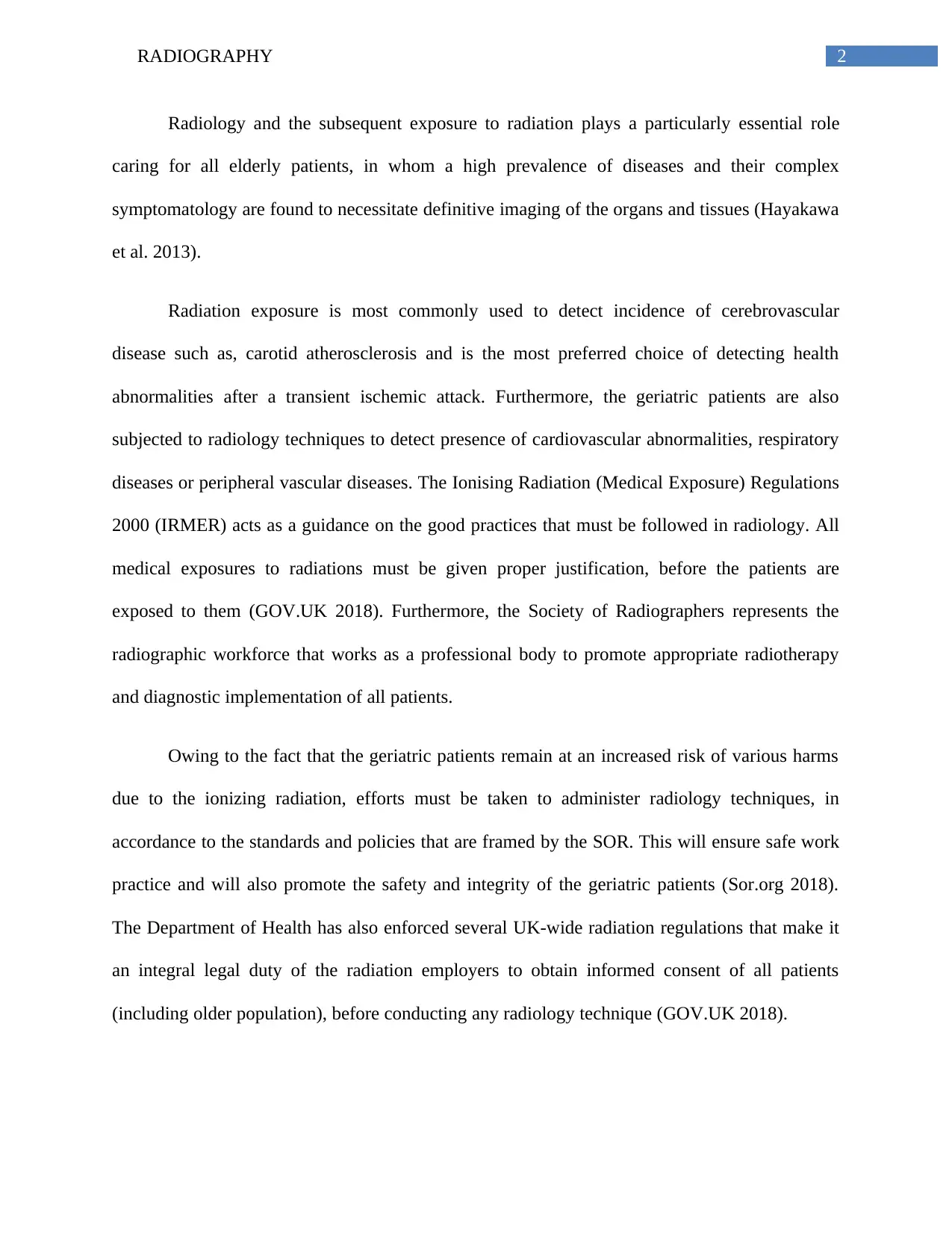
2RADIOGRAPHY
Radiology and the subsequent exposure to radiation plays a particularly essential role
caring for all elderly patients, in whom a high prevalence of diseases and their complex
symptomatology are found to necessitate definitive imaging of the organs and tissues (Hayakawa
et al. 2013).
Radiation exposure is most commonly used to detect incidence of cerebrovascular
disease such as, carotid atherosclerosis and is the most preferred choice of detecting health
abnormalities after a transient ischemic attack. Furthermore, the geriatric patients are also
subjected to radiology techniques to detect presence of cardiovascular abnormalities, respiratory
diseases or peripheral vascular diseases. The Ionising Radiation (Medical Exposure) Regulations
2000 (IRMER) acts as a guidance on the good practices that must be followed in radiology. All
medical exposures to radiations must be given proper justification, before the patients are
exposed to them (GOV.UK 2018). Furthermore, the Society of Radiographers represents the
radiographic workforce that works as a professional body to promote appropriate radiotherapy
and diagnostic implementation of all patients.
Owing to the fact that the geriatric patients remain at an increased risk of various harms
due to the ionizing radiation, efforts must be taken to administer radiology techniques, in
accordance to the standards and policies that are framed by the SOR. This will ensure safe work
practice and will also promote the safety and integrity of the geriatric patients (Sor.org 2018).
The Department of Health has also enforced several UK-wide radiation regulations that make it
an integral legal duty of the radiation employers to obtain informed consent of all patients
(including older population), before conducting any radiology technique (GOV.UK 2018).
Radiology and the subsequent exposure to radiation plays a particularly essential role
caring for all elderly patients, in whom a high prevalence of diseases and their complex
symptomatology are found to necessitate definitive imaging of the organs and tissues (Hayakawa
et al. 2013).
Radiation exposure is most commonly used to detect incidence of cerebrovascular
disease such as, carotid atherosclerosis and is the most preferred choice of detecting health
abnormalities after a transient ischemic attack. Furthermore, the geriatric patients are also
subjected to radiology techniques to detect presence of cardiovascular abnormalities, respiratory
diseases or peripheral vascular diseases. The Ionising Radiation (Medical Exposure) Regulations
2000 (IRMER) acts as a guidance on the good practices that must be followed in radiology. All
medical exposures to radiations must be given proper justification, before the patients are
exposed to them (GOV.UK 2018). Furthermore, the Society of Radiographers represents the
radiographic workforce that works as a professional body to promote appropriate radiotherapy
and diagnostic implementation of all patients.
Owing to the fact that the geriatric patients remain at an increased risk of various harms
due to the ionizing radiation, efforts must be taken to administer radiology techniques, in
accordance to the standards and policies that are framed by the SOR. This will ensure safe work
practice and will also promote the safety and integrity of the geriatric patients (Sor.org 2018).
The Department of Health has also enforced several UK-wide radiation regulations that make it
an integral legal duty of the radiation employers to obtain informed consent of all patients
(including older population), before conducting any radiology technique (GOV.UK 2018).
⊘ This is a preview!⊘
Do you want full access?
Subscribe today to unlock all pages.

Trusted by 1+ million students worldwide
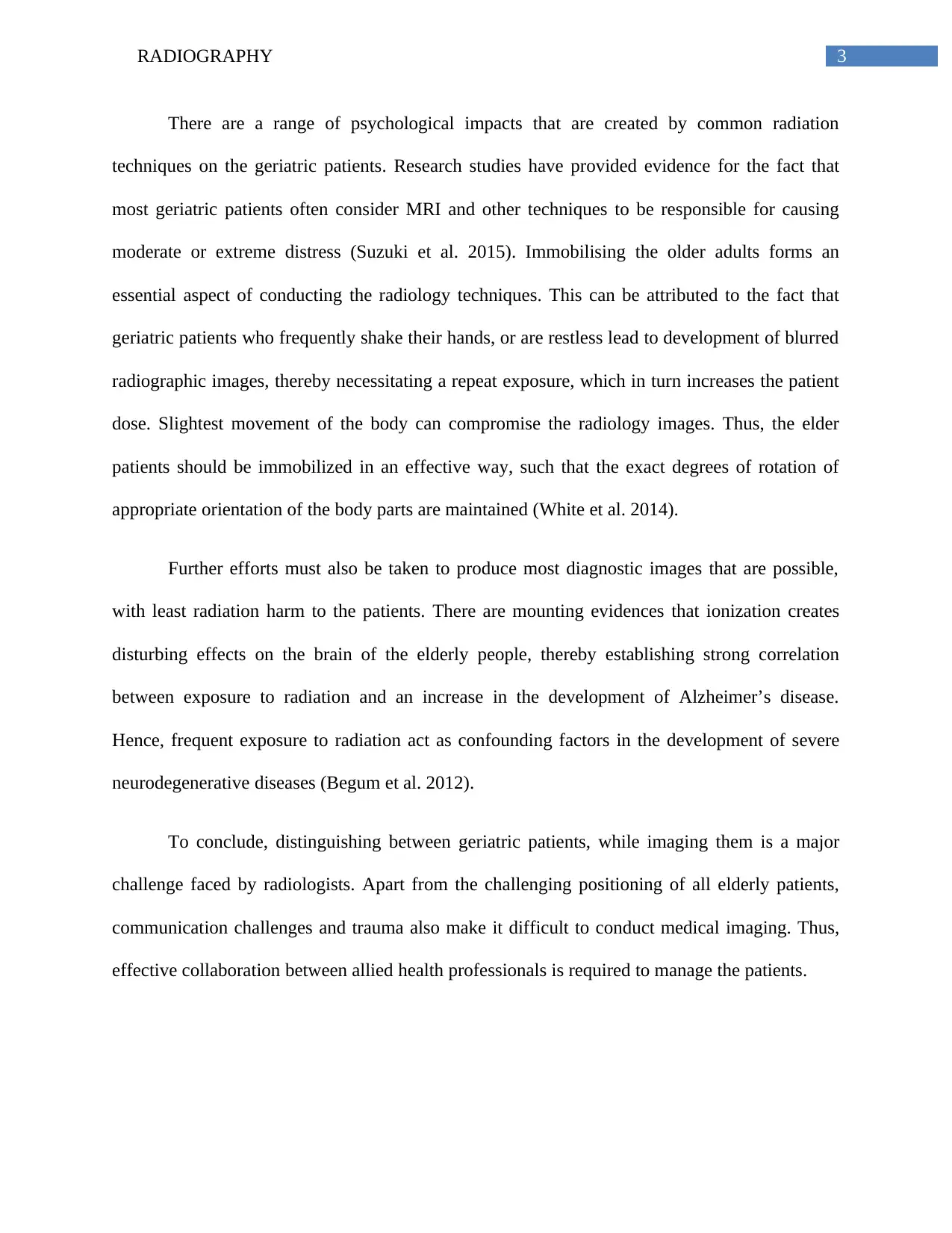
3RADIOGRAPHY
There are a range of psychological impacts that are created by common radiation
techniques on the geriatric patients. Research studies have provided evidence for the fact that
most geriatric patients often consider MRI and other techniques to be responsible for causing
moderate or extreme distress (Suzuki et al. 2015). Immobilising the older adults forms an
essential aspect of conducting the radiology techniques. This can be attributed to the fact that
geriatric patients who frequently shake their hands, or are restless lead to development of blurred
radiographic images, thereby necessitating a repeat exposure, which in turn increases the patient
dose. Slightest movement of the body can compromise the radiology images. Thus, the elder
patients should be immobilized in an effective way, such that the exact degrees of rotation of
appropriate orientation of the body parts are maintained (White et al. 2014).
Further efforts must also be taken to produce most diagnostic images that are possible,
with least radiation harm to the patients. There are mounting evidences that ionization creates
disturbing effects on the brain of the elderly people, thereby establishing strong correlation
between exposure to radiation and an increase in the development of Alzheimer’s disease.
Hence, frequent exposure to radiation act as confounding factors in the development of severe
neurodegenerative diseases (Begum et al. 2012).
To conclude, distinguishing between geriatric patients, while imaging them is a major
challenge faced by radiologists. Apart from the challenging positioning of all elderly patients,
communication challenges and trauma also make it difficult to conduct medical imaging. Thus,
effective collaboration between allied health professionals is required to manage the patients.
There are a range of psychological impacts that are created by common radiation
techniques on the geriatric patients. Research studies have provided evidence for the fact that
most geriatric patients often consider MRI and other techniques to be responsible for causing
moderate or extreme distress (Suzuki et al. 2015). Immobilising the older adults forms an
essential aspect of conducting the radiology techniques. This can be attributed to the fact that
geriatric patients who frequently shake their hands, or are restless lead to development of blurred
radiographic images, thereby necessitating a repeat exposure, which in turn increases the patient
dose. Slightest movement of the body can compromise the radiology images. Thus, the elder
patients should be immobilized in an effective way, such that the exact degrees of rotation of
appropriate orientation of the body parts are maintained (White et al. 2014).
Further efforts must also be taken to produce most diagnostic images that are possible,
with least radiation harm to the patients. There are mounting evidences that ionization creates
disturbing effects on the brain of the elderly people, thereby establishing strong correlation
between exposure to radiation and an increase in the development of Alzheimer’s disease.
Hence, frequent exposure to radiation act as confounding factors in the development of severe
neurodegenerative diseases (Begum et al. 2012).
To conclude, distinguishing between geriatric patients, while imaging them is a major
challenge faced by radiologists. Apart from the challenging positioning of all elderly patients,
communication challenges and trauma also make it difficult to conduct medical imaging. Thus,
effective collaboration between allied health professionals is required to manage the patients.
Paraphrase This Document
Need a fresh take? Get an instant paraphrase of this document with our AI Paraphraser
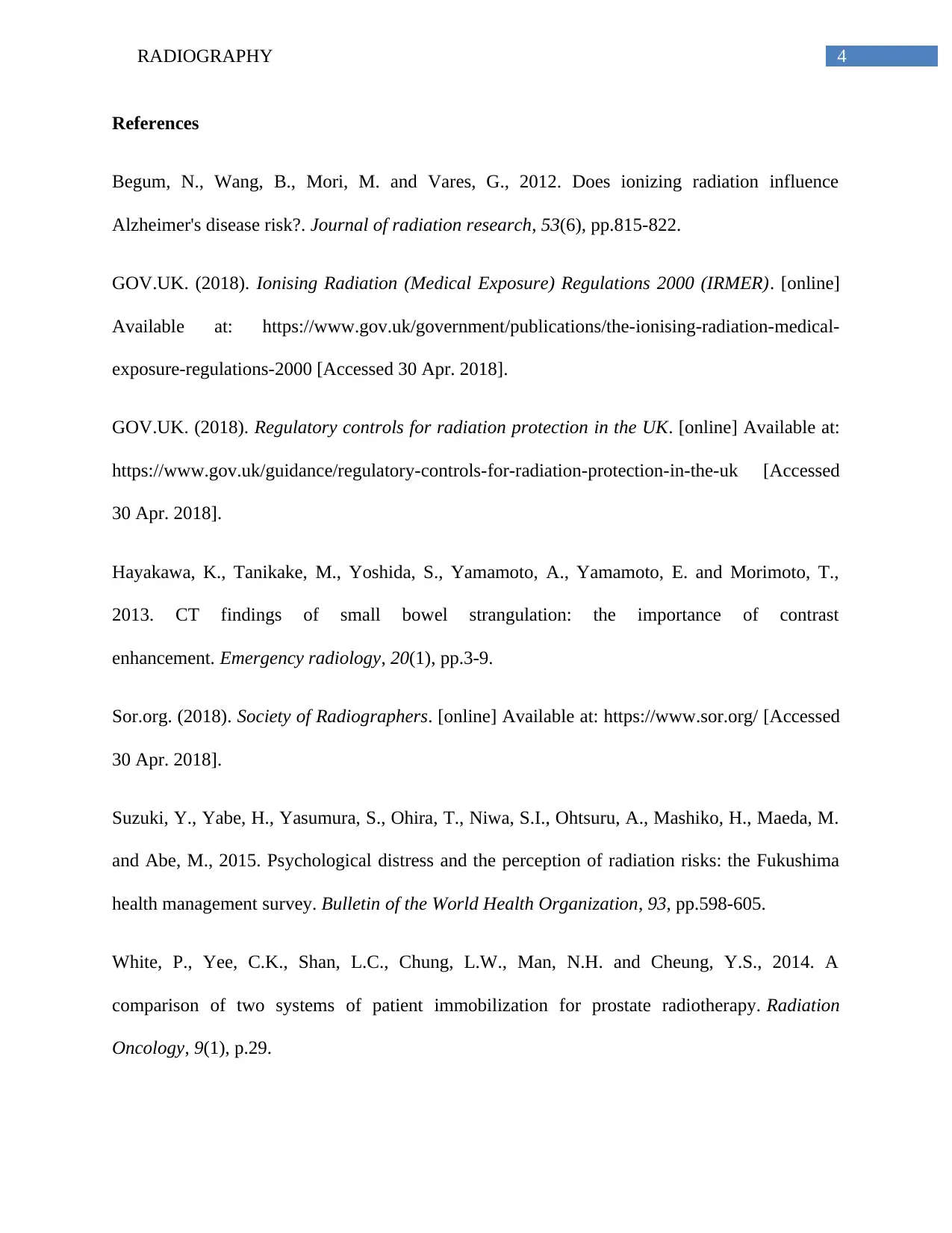
4RADIOGRAPHY
References
Begum, N., Wang, B., Mori, M. and Vares, G., 2012. Does ionizing radiation influence
Alzheimer's disease risk?. Journal of radiation research, 53(6), pp.815-822.
GOV.UK. (2018). Ionising Radiation (Medical Exposure) Regulations 2000 (IRMER). [online]
Available at: https://www.gov.uk/government/publications/the-ionising-radiation-medical-
exposure-regulations-2000 [Accessed 30 Apr. 2018].
GOV.UK. (2018). Regulatory controls for radiation protection in the UK. [online] Available at:
https://www.gov.uk/guidance/regulatory-controls-for-radiation-protection-in-the-uk [Accessed
30 Apr. 2018].
Hayakawa, K., Tanikake, M., Yoshida, S., Yamamoto, A., Yamamoto, E. and Morimoto, T.,
2013. CT findings of small bowel strangulation: the importance of contrast
enhancement. Emergency radiology, 20(1), pp.3-9.
Sor.org. (2018). Society of Radiographers. [online] Available at: https://www.sor.org/ [Accessed
30 Apr. 2018].
Suzuki, Y., Yabe, H., Yasumura, S., Ohira, T., Niwa, S.I., Ohtsuru, A., Mashiko, H., Maeda, M.
and Abe, M., 2015. Psychological distress and the perception of radiation risks: the Fukushima
health management survey. Bulletin of the World Health Organization, 93, pp.598-605.
White, P., Yee, C.K., Shan, L.C., Chung, L.W., Man, N.H. and Cheung, Y.S., 2014. A
comparison of two systems of patient immobilization for prostate radiotherapy. Radiation
Oncology, 9(1), p.29.
References
Begum, N., Wang, B., Mori, M. and Vares, G., 2012. Does ionizing radiation influence
Alzheimer's disease risk?. Journal of radiation research, 53(6), pp.815-822.
GOV.UK. (2018). Ionising Radiation (Medical Exposure) Regulations 2000 (IRMER). [online]
Available at: https://www.gov.uk/government/publications/the-ionising-radiation-medical-
exposure-regulations-2000 [Accessed 30 Apr. 2018].
GOV.UK. (2018). Regulatory controls for radiation protection in the UK. [online] Available at:
https://www.gov.uk/guidance/regulatory-controls-for-radiation-protection-in-the-uk [Accessed
30 Apr. 2018].
Hayakawa, K., Tanikake, M., Yoshida, S., Yamamoto, A., Yamamoto, E. and Morimoto, T.,
2013. CT findings of small bowel strangulation: the importance of contrast
enhancement. Emergency radiology, 20(1), pp.3-9.
Sor.org. (2018). Society of Radiographers. [online] Available at: https://www.sor.org/ [Accessed
30 Apr. 2018].
Suzuki, Y., Yabe, H., Yasumura, S., Ohira, T., Niwa, S.I., Ohtsuru, A., Mashiko, H., Maeda, M.
and Abe, M., 2015. Psychological distress and the perception of radiation risks: the Fukushima
health management survey. Bulletin of the World Health Organization, 93, pp.598-605.
White, P., Yee, C.K., Shan, L.C., Chung, L.W., Man, N.H. and Cheung, Y.S., 2014. A
comparison of two systems of patient immobilization for prostate radiotherapy. Radiation
Oncology, 9(1), p.29.
1 out of 5
Your All-in-One AI-Powered Toolkit for Academic Success.
+13062052269
info@desklib.com
Available 24*7 on WhatsApp / Email
![[object Object]](/_next/static/media/star-bottom.7253800d.svg)
Unlock your academic potential
Copyright © 2020–2025 A2Z Services. All Rights Reserved. Developed and managed by ZUCOL.
